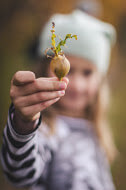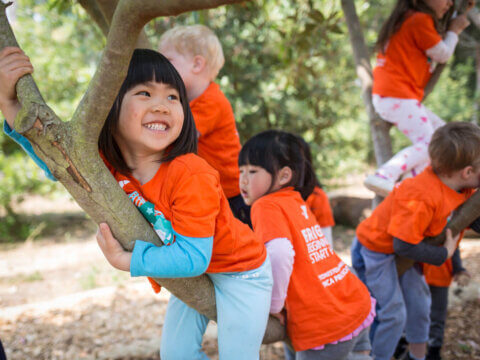COMING TO OUR 30 SENSES: In an era of sensory dysfunction, are we creating environments in which our children are less alive? And in greater danger?
Parents, as well as health and educational professionals, are increasingly concerned about the increase in children’s sensory processing difficulties. For some children, perhaps for most, spending time in natural environments can open new doorways to the world.
Here’s some good news. Human beings have an array of usually untapped “super senses,” ones that can be activated, developed and tuned.
Most scientists who study human perception no longer assume that the five senses — taste, touch, smell, sight, and hearing — are the only ways to know the world. The current number of senses ranges from a conservative ten senses to as many as thirty, including blood-sugar levels, empty stomach, thirst, joint position and more.
The number of known human senses is extraordinary, and even those five basic senses can be supercharged.
Ever wonder why you have two nostrils? Researchers at the University of California – Berkeley did. They published their findings in the journal Nature Neuroscience. Jay Gottfried, a professor of neurology at Northwestern University, wrote: “What this study highlights most for me is that the human sense of smell is a lot better than many people think it is. It’s true that narrow visual and auditory streams comprise the primary sensory currents of our lives. But all of our senses are capable of more than what we assume.’’
As I reported in The Nature Principle, the researchers fitted college undergraduates with taped-over goggles, earmuffs, and work gloves to block other senses, then set them loose in a field; most of the students could follow a thirty-foot-long trail of chocolate perfume and even changed direction precisely where the invisible path took a turn. The subjects also were able to smell better with two functioning nostrils, which researchers likened to hearing in stereo. One researcher postulated that the brain gathers odor “images’’ from each nostril to construct a composite picture of the trail. The students found themselves zigzagging, a technique employed by dogs and other animals that make their living with their noses. The study also found that the students’ olfactory tracking abilities improved with practice.
There are many ways of knowing the world. In 2010, scientists at University College in London published the results of a study suggesting that human beings may be hardwired with an inner sense of direction. Other research suggests that when people rely exclusively on GPS units to find their way, they can lose some of their neurological ability for mental mapping.
Proprioception — the awareness of your body’s position in space, including movement and balance — makes it possible for us to touch our noses when our eyes are closed. We share a latent talent with dolphins and bats: echolocation, the ability to locate objects by interpreting sounds bouncing off of them.
In 2009, researchers at Madrid’s University of Alcalá de Henares showed how people could identify objects around them, without needing to “see” them, through the echoes of human tongue clicks. According to the lead researcher, echoes are also perceived through vibrations in ears, tongue, and bones. This refined sense has been learned by trial and error by some blind people and even by some sighted individuals.
“In certain circumstances, we humans could rival bats in our echolocation or biosonar capacity,” said Juan Antonio Martínez Rojas, lead author of the study. “Lots of things, like an empty room, don’t make a sound, but they do structure it. They give it shape, which people can see without seeing. I have had students listen to sounds broadcast between two boards and be able to tell me whether there was enough space between the boards for them to fit through.” Human echolocation can be activated without technology, according to Lawrence D. Rosenblum, a professor of psychology at University of California – Riverside. To him, it’s all about “hearing” a world that exists beyond what we normally mistake for silence.
With our growing knowledge of this expanded palette of human senses, it seems even more unjust to deprive children of these “super powers.” Yet, society is on a trajectory to use less of our natural senses, not more. In a dominating digital environment, at school, at work and at home, people are required to expend enormous effort blocking out many of the human senses — including the ones they don’t even know they have. Isn’t that the very definition of being less alive? What parent wants his or her child to be less alive? Who among us wants to be less alive?
 The point here is not that technology is bad. A GPS unit can be invaluable when you’re lost, and the computer I’m typing on does connect me to millions of people almost instantly. But none of us wants our complex senses to go unused, or even atrophy. We certainly don’t want that for our kids.
The point here is not that technology is bad. A GPS unit can be invaluable when you’re lost, and the computer I’m typing on does connect me to millions of people almost instantly. But none of us wants our complex senses to go unused, or even atrophy. We certainly don’t want that for our kids.
This underuse of senses is not without consequences. Pediatric occupational therapist Angela Hanscom, in a blog post for C&NN and book, Balanced and Barefoot, reports that children “are not moving like they did in years past. It is rare to find children rolling down hills, spinning in circles just for fun, or climbing trees at great heights. In fact, our society often discourages this type of play due to liability issues and fear of falls.” Partially as a result, she argues, “more and more children are presenting with sensory issues these days.”
A cautionary note. The causes of sensory disorders for some children are purely neurological or physiological, relatively independent of the environment. Parents of these children should not feel guilty if their child hasn’t spent much time outdoors. For them, nature experiences may make little difference. But for some children with sensory challenges, and for children and adults without these disorders, spending time in nature can help all of us develop a deeper experience of life and its mysteries.
Developing those senses can also help make our children safer. Which brings us to the so-called sixth sense To some, that means intuition, to others extrasensory perception, and to others, a more specific definition: the ability to unconsciously detect danger — especially when combined with greater knowledge of the natural world.
In December 2004, as the devastating Asian tsunami approached, Jarawa tribespeople, along with some animals, reportedly sensed or detected sounds from the approaching wave, or other unusual natural activity, long before the water struck the shore. They fled to higher ground. The Jarawa used tribal knowledge of nature’s warning signs, explained V. R. Rao, director of the Anthropological Survey of India, based in Kolkata. “They got wind of impending danger from biological warning signals, like the cry of birds and change in the behavioral patterns of marine animals.” In the Jarawa’s case, the simplest explanation may be that the sixth sense is the sum of all the other senses put together, combined with everyday nature-knowledge.
Researchers at Washington University in St. Louis point to the anterior cingulate cortex, the brain’s early warning system, which is better at picking up subtle warning signs than scientists had previously thought. Joshua W. Brown, director of the Cognitive Control Lab, Indiana University – Bloomington, coauthored a study reported in 2005, in the journal Science. “It makes sense that this mechanism exists because there are plenty of situations in our everyday lives that require the brain to monitor subtle changes in our environment and adjust our behavior, even in cases where we may not necessarily be aware of the conditions that prompted the adjustment,” he wrote. “In some cases, the brain’s ability to monitor subtle environmental changes and make adjustments may actually be even more robust if it takes place on a subconscious level.”
Ron Rensink, an associate professor in both psychology and computer science at the University of British Columbia, has investigated the sixth sense, which he calls “mindsight,” as a way to understand how people can have accurate “intuition” that something is about to happen.
“In a way, it’s like a ‘first strike’ system…that we use without conscious thought,” Rinsing told the Monitor, the journal of the American Psychological Association.
His research suggests that vision is, in fact, a collection of abilities, not just one sense — and that the brain can receive, through light, a kind of pre-image vision.
In other research, the U.S. military has studied how some soldiers apparently use latent senses to detect roadside bombs and other hazards in war zones. Researchers found that two groups were particularly good at sensing danger: soldiers from rural areas who spent more time outdoors, and those who grew up in tough urban neighborhoods. According to Army Sgt. Maj. Todd Burnett, who who conducted the research, the soldiers who could detect anomalies “just seemed to pick up things much better. . . . They know how to look a the entire environment.” And the other young soldiers, the ones who were raised with Game Boys and spent weekends at the mall? By and large, these enlistees lacked the ability to detect nuances that might enable a soldier to spot a hidden bomb.
One simple explanation may be physiological. Australian researchers suggest that a worldwide increase in cases of myopia — nearsightedness — is linked to children and young people spending less time outdoors, where eyes are conditioned to focus on longer distances. The most recent research suggests an additional cause or aggravator of myopia: lack of sunlight. But eyesight can’t be the only factor. In addition to bestter vision, the sixth sense may include more acute hearing, an attuned sense of smell, a sense of where one’s body is in space — all of these abilities operating simultaneously — as well as greater knowledge of clues and cues in the natural world.
Developing the natural super senses early in life makes us safer; it increases our ability to learn and create; and, it gives us perhaps the most important gift — it improves our measurement-defying ability to more fully engage in life; to feel, to sense wonder and joy.
Shouldn’t we then be creating environments in our schools, homes, workplaces and cities that enhance the power of our natural senses?
-
Network News
Earth Day: Young leaders advocate for change
-
Feature
Nature photographer Dudley Edmondson has a vision for the representation of Black and Brown faces in the outdoors
-
Richard Louv
EARTH MONTH: You're part of the New Nature Movement if....
-
Voices
Placemaking: How to build kinship and inclusive park spaces for children with disabilities
-
Network News
Children & Nature Network founders release report on global factors influencing the children and nature movement








Commentaries on the C&NN website are offered to share diverse points-of-view from the global children and nature movement and to encourage new thinking and debate. The views and opinions expressed are those of the author(s) and do not necessarily reflect the position of C&NN. C&NN does not officially endorse every statement, report or product mentioned.